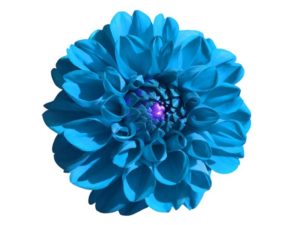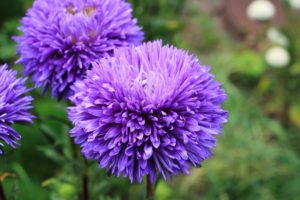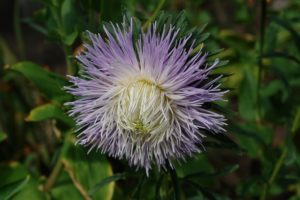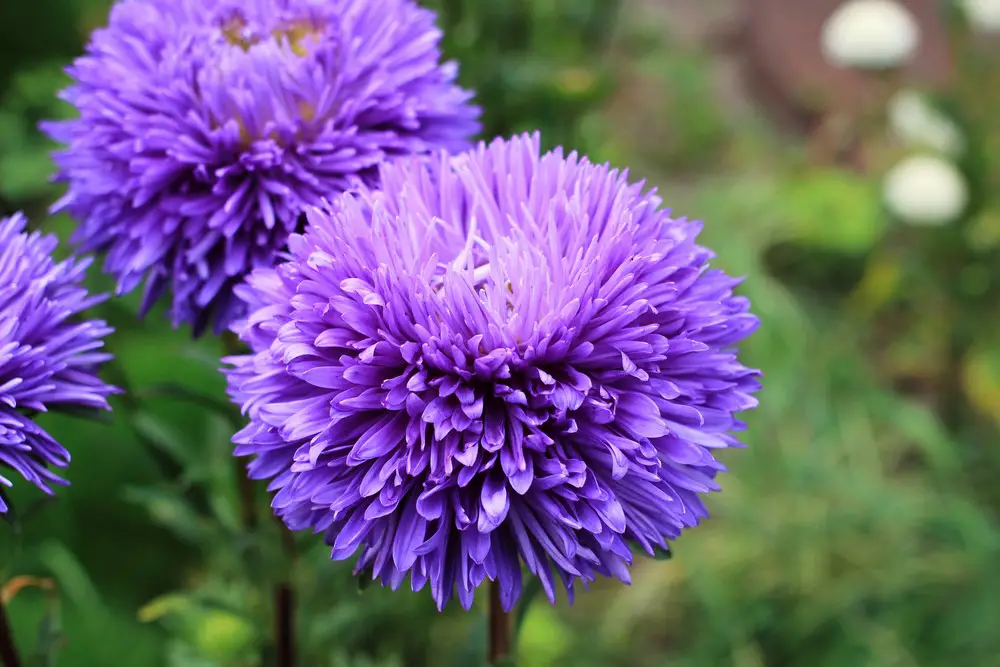Have you noticed that people from a family have a distinct look of similarity, but in fact, all appear to be very different? It’s almost as though there’s a look of commonality, and yet, they are individually so diverse as to possibly not belong.
That doesn’t just apply to humans but also plants!
How often have you heard someone say ‘oh look at that plant, it’s a ‘such and such’ and you point elsewhere and say ‘no, that’s a ‘such and such’ and you’re told ‘no it’s not, but it’s a member of the same family.’
Confusing? Not really. Maybe you look like your father but take after your mother. Plants are not so very different.
Look at Asters
Let’s look at Asters – Blue Asters. There are so many species and so many different ‘looks’ that a person could be forgiven for not recognizing them all as part of the Aster family.
Asters are perennials that bloom from Summer to Fall. They are quite hardy plants and tolerate all temperatures. They vary in size and shape, color, and appearance, not unlike the families we discussed earlier.
Some of them look like small chrysanthemums, and others look very much like daisies. It’s fascinating to look at the changes in appearance, and every single one is most attractive.
A bit of information with a difference: the name (Aster) heralds from the Ancient Greek word for star (because of their daisy shape)!
All Different but All Asters
Here are four very striking images of different (and some unusual) Asters for you to see.
| First we have a King Sized Blue Aster that’s opening so you can almost see all the way inside. |  |
|---|---|
| Second, there is what is known as a Blue Clawlike China Aster and is another quite lovely but different version of the Aster. |  |
| The Third Image, bottom left, is a crush of Asters, a profusion of the plants colored blue mixed with dark pink and white in one single bloom. |  |
| Last but not least, the bottom right image is a Blue Aster Grey Haired Lady. |  |
Even the names are so descriptive and unusual.
How to Grow Asters
Prepare a Site
• Asters thrive in climates that have medium temperature and moist Summers, and even lower night temperatures.
• They shun the midday sun and much prefer partial sun.
• They like moist soil with good drainage.
• It’s a good idea to mix compost into the soil before planting.
Planting Asters
• When you grow your Aster from seed, remember that the germination needs to be kept even.
Put Them In the Fridge
• A good idea is to start the seed indoors during the Winter and maybe keep them in your fridge for about four to six weeks to create the impression of winter dormancy.
• Asters need a period of cold weather to jumpstart their germination.
• Sow the seed about one inch deep into the soil. Find a reasonably sunny spot (not full sun) in your home.
• You should not plant the seeds directly into the ground until the last frosts have passed.
• The best time of the year to plant baby Asters is in mid to end of Spring.
• Space out the young Asters, one to three feet apart – depending on the type of Aster and how big it’s expected to grow.
• Water the plants once you’ve planted them.
• Mulch the plants after planting to keep the soil cool and keep away the weeds.
• Pollinators – especially bees and butterflies – are very attracted to Asters.
Growth and Maintenance
• Add a thin layer of compost or balanced fertilizer with a two-inch layer of mulch around the plants. Do this each Spring to achieve healthy growth.
• If your plants get less than one inch of rain per week, you will need to remember to water them regularly during the Summer.
Moisture Sensitive
• Asters are moisture sensitive. Too much or too little water and your plant will shed its lower foliage, and you could end up losing the whole plant.
• If necessary, you might need to try a different watering system if your plants start failing for this reason.
• This plant must have excellent drainage. You could build it up so that it forms a raised bed in your garden – that could help with the drainage and also the spreading of roots.
• The tall varieties will require staking to give them the support they need and stop them from falling down while they grow.
• To get a fuller, more voluminous plant and have more blooms, pinch back the Asters a couple of times in the early Summer – it won’t do any harm to the plant – in fact, it will be good for its growth.
• It’s best to cut back your Asters either in the winter after the foliage has died or wait through winter to have something nice in your garden offseason.
Reseeding Goes Wrong
• A point to note is that any Aster flowers that reach maturity might fully reseed themselves. Still, the result could be that the Asters might produce flowers of a different color to the one you selected and the one you first planted.
• To maintain your Asters’ health and quality, make a point of dividing the plants every couple of years. Do it in the Spring, and your plants will continue to grow more vigorously than if left.
Michaelmas Daisies
• Asters are often called ‘Michaelmas daisies.’ It is pronounced like ficklemas. Apparently, this is due to the lateness of its blooming.
• Its height varies between 8 inches and several feet. The blooms themselves also vary in size. They could be between three to five-inch blossoms, or they might be smaller.
• To stop them from reseeding themselves, waiting until a flower dies and then deadhead it. By deadheading, the plants could continue to bloom until the first frosts.
Pay Attention
• If your Asters start to fail, it’s most probably because their roots are too wet. A common misconception is that the best way to help a plant grow is to keep watering. This is certain death for an Aster that prefers much drier conditions.
• Asters like to stretch out a little – in other words, they do spread and can become quite invasive. Keep an eye out for this and if they go too far, just cut them back, but consider this – they do make a lovely ground cover.
• When watering, try to avoid getting water on the leaves or the plant itself, as this could cause fungal spores and other ‘nasties’ to arrive. Better to aim the hose at the foot of the plants; that way is the safe way.
Deadheading
This is a straightforward but necessary procedure. It means to remove the dead flowers. By doing this, you’re promoting more blossoms from your plant, so you’re actually helping your plant and preventing it from reseeding, which, as we discussed, is to be avoided. Depending on the flower, it can require particular degrees of precision. However, the easy-going, highly tolerant Aster is easy to deadhead – as follows:
By Hand?
If the plant is soft, you can do it by hand – although you need long, sharp fingernails. My preference has always been a small pair of gardening shears.
Or Shears
Take your shears (they’re sharp, which makes things easier) and cut off the flower just beneath the head (you don’t even need to cut at an angle this time) on the stem. Make sure you take off every dead bloom; even if your plant looks terribly bare, it will bloom again in no time.
Or Scissors
If you don’t have garden shears, then you could use a really sharp pair of scissors.
The point of deadheading – apart from preventing your plant from reseeding – is to renew its energy, which it should then put into producing more flowers! Your plant will thrive after good deadheading!
Colors and Varieties
The Aster is nothing if not vociferous and versatile. Blue, pink, purple, and white is the primary colors of the Aster, although it has also been known to produce some multi-color blooms.
Like the different people on earth, so is the Aster, a plant with many faces, many other appearances, and many shapes and sizes.
Easy to Grow
The plant is easy to grow and just as easy to maintain so that whichever version of this species you choose, all you have to do is follow the basic ground rules I’ve set out for you, and you have a lovely plant in the garden which you’ll enjoy.
Container Planting
Have you thought about choosing a variety of Aster that would be good for container planting? Because the plant is so easy to grow and is not high maintenance, it responds well to living in a container, and it also looks good.
Imagine a couple of hanging baskets at the front door or some large earthenware pots at the entrance. Maybe some window boxes – when filled with the right type of Aster – would look quite a refreshing sight with the right color scheme! Whatever the purpose, it seems there’s the correct type of Aster for it!
Patricia Godwin
Editor at Large

